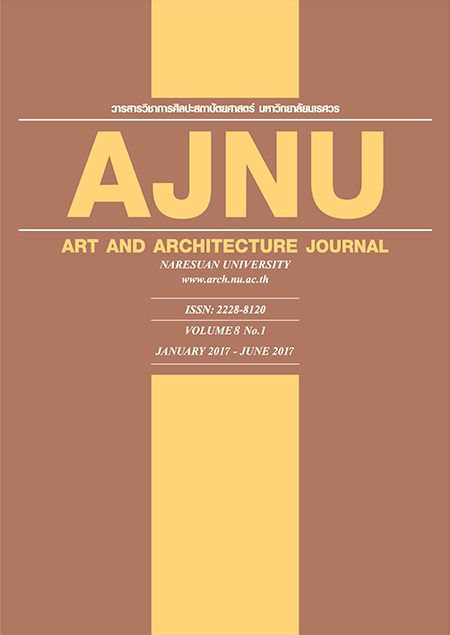การพัฒนาหมึกพิมพ์สกรีนจากสารยึดติดและสารให้สีธรรมชาติ Development of screen inks from natural mordant and colorant
Main Article Content
Abstract
การวิจัยครั้งนี้เป็นการวิจัยพัฒนาโดยมีวัตถุประสงค์ 1) เพื่อพัฒนาหมึกพิมพ์สกรีนจากสารยึดติด 3 ชนิด คือ ยางกล้วย ยางมะละกอ ยางพารา และสารช่วยการยึดติด 3 ชนิด คือ จุนสี เกลือแกง สารส้ม 2) เพื่อทดสอบความเข้มของสีหมึกพิมพ์จากสารให้สี สีเหลืองจากผงขมิ้นกับลูกพุด สีแดงจากดอกกระเจี๊ยบแห้งกับเปลือกผลแก้วมังกร สีน้ำเงินจากครามกับฮ่อม สีดำ จากเมล็ดเงาะกับมะเกลือ 3) เพื่อวิเคราะห์การยึดติดระหว่างสารยึดติด 3 ชนิด คือ ยางกล้วย ยางมะละกอ ยางพารา และการเติมสารช่วยในการยึดติด 3 ชนิด คือ จุนสี เกลือแกง สารส้ม 4) เพื่อศึกษาวิเคราะห์การนำหมึกพิมพ์สกรีนจากจากธรรมชาติไปใช้ประโยชน์ ในการศึกษาครั้งนี้โดยการทดลอง โดยการผสมหมึกพิมพ์ด้วยสารยึดติด 3 ชนิดและสารช่วยยึดติด 3 ชนิด และนำไปทำการพิมพ์บนผ้าฝ้ายอย่างละ 30 ชิ้น การสำรวจความคิดเห็น กลุ่มตัวอย่าง ได้แก่ นักออกแบบผลิตภัณฑ์และครูศิลปะที่เข้าชมงานศิลปะและการออกแบบนานาชาติครั้งที่ 2 ปี 2558 ณ มหาวิทยาลัยราชภัฎนครสวรรค์ จำนวน 30 คน โดยวิธีการเลือกกลุ่มตัวอย่างแบบบังเอิญ เครื่องมือที่ใช้ได้แก่แบบสอบถาม ผลการวิจัยพบว่า 1) ค่าความดำของหมึกพิมพ์จากสารยึดติด 3 ชนิด หมึกพิมพ์ที่ใช้ยางพาราเป็นสารยึดติดมีความเข้มของสีทุกสีมากที่สุดรองลงมาได้แก่หมึกพิมพ์ที่ใช้สารยึดติดจากยางกล้วยและน้อยที่สุดได้แก่สารยึดติดจากยางมะละกอ 2) ความเข้มของสีหมึกพิมพ์สีเหลืองมีค่าของผงขมิ้นกับเมล็ดลูกพุดมีค่าใกล้เคียงกันโดยสีจากผงขมิ้นมีความเข้มของสีมากกว่า สีแดงดอกกระเจี๊ยบแห้งกับผลแก้วมังกร สีจากดอกกระเจี๊ยบมีความเข้มของสีมากกว่า สีน้ำเงินระหว่างครามกับฮ่อม ครามจะมีความเข้มของสีมากกว่า สีดำระหว่างเมล็ดเงาะกับมะเกลือ สีจากมะเกลือจะมีความเข้มของสี มากกว่า 3) การยึดติดจากสารเติมแต่ง 3 ชนิด พบว่าหมึกพิมพ์ที่เติมเกลือแกงมีค่าของการยึดติดได้ดีที่สุดรองลงมาได้แก่สารส้มและน้อยที่สุดได้แก่จุนสี 4) ความคิดเห็นของกลุ่มตัวอย่างที่มีต่อหมึกพิมพ์สกรีนจากธรรมชาติกลุ่มตัวอย่างเห็นว่าสามารถนำมาใช้สร้างสรรค์ลายบนผ้าเพื่องานด้านผลิตภัณฑ์และใช้กับงานด้านศิลปะเพื่อการเรียนการสอนงานพิมพ์ได้
This research took on research and development approach aiming at 1) developing screen inks from 3 kinds of natural mordant, i.e. banana sap, papaya latex, and hevea brasiliensis, and 3 kinds of additive, i.e. copper sulfate, sodium chloride, and aluminium sulfate; 2) testing the value if density of ink colors for yellow: curcuma powder and gardenia fruit; red: dried rosella and pitaya; blue:n indigo and baphicacanthus cusia; black : rambutan seeds and ebony fruits; 3) examining the fastness of the 3 kinds of natural mordant: banana sap, papaya latex, and hevea brasiliensis and the 3 kinds of additive: copper sulfate, sodium chloride, and aluminium sulfate; and 4) exploring the utilization of these natural screen inks. The experiment was carried out by preparing ink mixtures from the 3 kinds of mordant and 3 kinds of additive, and printing each one of them onto 30 cotton sheets. An opinion survey was conducted with the sample group, selected by means of accidental sampling, including 30 product designers and arts teachers who attended the 2nd International Arts and Designs, 2015 at Nakhon Sawan Rajabhat University, using the questionnaire as a tool. The research results were as follows. 1) Among the 3 types of mordant, the highest density value was found in para gum for every colors, followed by banana sap, papaya latex, respectively. 2) The density values of yellow were found similar in curcuma powder and gardenia fruit, with higher value in curcuma powder; red with higher value in rosella than pitaya; blue with higher value in indigo than baphicacanthus cusia; black with higher value in ebony fruit than rambutan seed. 3) The fastness values of the 3 type of additives were found highest in sodium chloride, followed by aluminum sulfate, and copper sulfate, respectively. 4) The respondents’ opinions on natural screen inks suggested that these inks can be used to create patterns on fabrics in both the product work and art work for the teaching and learning of printing work.

